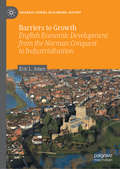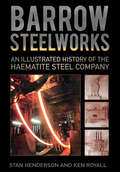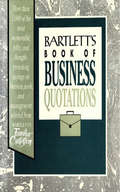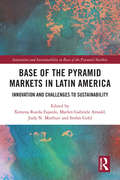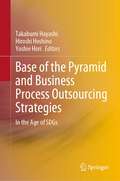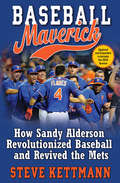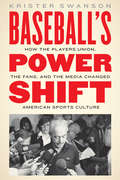- Table View
- List View
Barriers to Entry: Overcoming Challenges and Achieving Breakthroughs in a Chinese Workplace
by Paul RossThis book offers a unique perspective on the challenges that non-Chinese employed by Chinese companies face and provides insight into the issues foreign employees working for Chinese management encounter. As its source of content the book analyzes the experiences of those currently working for Chinese companies both inside and outside China and in exploring the dimensions of that experience lifts the veil on the inner workings of a Chinese company. By supplementing this primary analysis with secondary research that encompasses a wide range of disciplines (cross-cultural relations, Chinese management philosophy and practice, human resource management, linguistics, and aesthetics, etc.) the book serves as an invaluable resource for those engaged in the study of Chinese enterprise culture and management, cross-cultural relations, international business and human resource management.
Barriers to Growth in Small Firms (Routledge Library Editions: Small Business)
by J. Barber J. S. Metcalfe M. PorteousThis book, originally published in 1989, studies both the growth and the barriers to growth of small firms. It examines market and industrial structures, also the role of investment institutions and their handling of small business accounts. There are chapters on management attitudes and ability considered as a potential barrier to development, and other problems such as lack of finance and of a suitably qualified workforce. The book stresses the importance of communicating the latest advances in technology to small firms, and urges the need to re-think government tax and procurement policies.
Barriers to Growth: English Economic Development from the Norman Conquest to Industrialisation (Palgrave Studies in Economic History)
by Eric L. JonesThis book deals sequentially with major impediments to economic growth and their slow dissolution. It is original and quite different from standard economic history, which has always sought for one prime mover of the industrial revolution after another. These supposed positive forces are usually depicted as novel and little reference is made to inertia. Instead the barriers dealt with here run, in the first section, from early misallocations of resources to nineteenth-century reforms which of their nature indicate the problems to be overcome. The second section deals with more physical impediments and shocks, such as floods and settlement fires. These too are ignored in ordinary treatments, which this book will supplement or even replace. It will be of interest to academic economic historians and practitioners of neighbouring subjects such as economists, historians, historical geographers, and of course their students.
Barrio Dreams: Puerto Ricans, Latinos, and the Neoliberal City
by Arlene DávilaAnalyzing the simultaneous gentrification and Latinization of what is known as El Barrio or Spanish Harlem, Barrio Dreams makes a compelling case that--despite neoliberalism's race- and ethnicity-free tenets--dreams of economic empowerment are never devoid of distinct racial and ethnic considerations.
Barron's E-Z Business Mathematics
by Thomas P. Walsh Calvin GooznerThis self-teaching manual reviews arithmetic skills as they apply to business records and functions. Topics reviewed include fractions, decimals, calculating percentages, the fundamentals of statistics and business graphics, measurements in the English and metric systems, and applications of mathematics to banking, investing, loans, and setting up a business. Barron's continues its ongoing project of updating, improving, and giving handsome new designs to its popular list of Easy Way titles, now re-named Barron's E-Z Series. The new cover designs reflect the books' brand-new page layouts, which feature extensive two-color treatment, a fresh, modern typeface, and more graphic material than ever. Charts, graphs, diagrams, instructive line illustrations, and where appropriate, amusing cartoons help to make learning E-Z. Barron's E-Z books are self-teaching manuals focused to improve students' grades across a wide array of academic and practical subjects. For most subjects, the skill level ranges between senior high school and college-101 standards. In addition to their self-teaching value, these books are also widely used as textbooks or textbook supplements in classroom settings. E-Z books review their subjects in detail, using both short quizzes and longer tests to help students gauge their learning progress. All exercises and tests come with answers. Subject heads and key phrases are set in a second color as an easy reference aid.
Barron's Guide to Making Investment Decisions
by Douglas Sease John PrestboDramatic changes in the economy and the market demand a new edition of the bestselling guide. This revised volume helps readers to devise a lifetime investment program that minimizes risk and adapts easily to changing financial goals, markets, and investment trends. 24 cartoons. Index.
Barron's Real Estate Licensing Exams: Salesperson, Broker, and Appraiser (Barron's Educational Series)
by Jack P. Friedman Bruce Linderman<p>In recent years, legal, social, economic, and financial matters affecting real estate have become more complex, creating greater educational needs for those who are engaged in the real estate business. In today's environment, a salesperson, broker, or appraiser cannot survive solely on a pleasant disposition and a neat appearance. <p>Real estate professionals must be aware of and obey federal, state, and local regulations. They need in-depth knowledge of each property being brokered, including its physical surroundings and its economic, legal, social, and political environment. In recognition of these needs, most states have adopted more stringent standards for the licensure of real estate brokers and salespersons. <p>These standards include more education, more rigorous examinations, or both. Population mobility, the need for licensure reciprocity, increased federal regulation, and greater communication and cooperation between state license law officials have all led to greater uniformity in real estate licensing standards. <p>This study guide and test preparation manual has been updated to provide the latest information in real estate finance, federal law and regulation, and appraisal license requirements. <p> <li>Explains all aspects of real estate law and finance, including contracts, deeds, appraisals, brokerage, leasing, mortgages, federal regulation of Fair Housing, Truth-in-Lending, and environmental matters <li>Presents more than 1,600 practice questions similar to those found on licensing exams, including 9 model tests <li>All questions answered and explained</li> </p>
Barrow Steelworks: An Illustrated History of the Haematite Steel Company
by Stanley Henderson K E RoyallDuring the second half of the nineteenth century, Barrow-in-Furness became a pioneer in iron and steel production. It went on to grow astronomically – owning collieries in three counties and ore mines in two – and became the largest integrated steelworks in north Lancashire and Cumberland and, at one time, the largest steelworks in the world. Its success was due, in part, to having the prestige of three dukes as directors, as well as to being only 2 miles away from one of the largest and richest iron ore mines in the country. Written by two former employees of the works, Barrow Steelworks chronicles the company’s past from the early empire through the inter-war and post-war years, the development of continuous casting in the 1950s, which revolutionised steelmaking, and, finally, the struggles and ultimate demise from the 1960s onwards of this once prominent industry.
Barry's Construction Technology: Analysis and Choice
by Tony Bryan Stephen EmmittUpdated resource guiding readers through the analysis and choices required to ensure a building will perform as expected Robin Barry’s Construction of Buildings was first published in 1958 as a five-volume set and rapidly became a standard work on the subject. Following Barry’s death in 2002, a two-volume format was adopted with new authors. Developed from an earlier book by Tony Bryan, this new third volume, Barry’s Construction Technology, extends the coverage to show how decisions about the design, production, maintenance and disposal of buildings may be thought through given the materials and technology available. The book challenges the reader to think about the consequences of making choices and decisions rather than relying on using what has been used before. Barry’s Construction Technology: Analysis and Choice includes information on: The climate emergency and the low carbon agenda as a fundamental part of construction technology analysis and choiceRegenerative design, net zero buildings, and the circular economy for the built environmentConstraints that location, legislation, codes and standards, sustainability, insurance, and commercial pressures apply to the performance of buildingsSpecific construction technology examples, with emphasis on questioning what we do and why, with the aim of informing and stimulating the reader to ask questions when confronted with all design and construction projects Barry’s Construction Technology: Analysis and Choice is an essential, practical, and up-to-date reference for undergraduate students of all building construction programmes including surveying, construction management, architectural technology, and architecture.
Barteca: The Challenge and Opportunity of Private Equity
by Lena G. Goldberg Michael S. KaufmanCase
Barter and Social Regeneration in the Argentinean Andes
by Olivia AngéDespite the pervasiveness of barter across societies, this mode of transaction has largely escaped the anthropologist's gaze. Drawing on data from fairs in the Argentinean Andes, this book explores fairs' embeddedness within religious celebration, arguing that barter is addressed as a sacrifice to catholic figures and local ancestors, and thus challenging a widespread view of barter as a non-monetary form of commodity exchange. Issues of value, identity, and exchange are considered, furthering our understanding of how social groups create themselves through material circulation.
Base of the Pyramid 3.0: Sustainable Development through Innovation and Entrepreneurship
by Stuart L. Hart Fernando Casado CanequeFor well over 4 billion people – approximately 60% of all humanity – annual income is less than $1,500. The term "Base of the Pyramid" was first coined by Stuart L. Hart and C.K. Prahalad in 2002 and has become synonymous with both the method by which we can more effectively address poverty and the opportunity that exists in a multi-trillion-dollar market. A whole new lexicon has emerged to describe this phenomenon, including new buzzwords and catch phrases like "inclusive business", "opportunities for the majority", "sustainable livelihoods", "pro-poor business" and “social business”, and thousands of new businesses, institutions and investment funds have been set up.In this ground-breaking new book, Stuart L. Hart and Fernando Casado Cañeque have worked with members of the BoP Global Network to shake the tree, look objectively at what has happened since 2002, highlight why earlier applications of BoP haven’t worked and propose new objectives and ways of working to formulate more sustainable solutions. The book challenges the reader and organizations to think about the mindset and purpose across whole organizations, open innovation rather than simply co-creation, and a complete review of the innovation ecosystem. Through this book, practitioners will gain a clearer insight into which business models can work within different communities to ensure a sustainable transition to improved local economies. Equally, the book is a must-read for researchers and students in the fields of entrepreneurship, innovation, sustainable development and environmental management.
Base of the Pyramid Markets in Affluent Countries: Innovation and challenges to sustainability (Innovation and Sustainability in Base of the Pyramid Markets)
by Stefan GoldThe Frugal Innovation and Bottom of the Pyramid Markets series comprises four volumes, covering theoretical perspectives, themes and various aspects of interest across four key geographical regions where BOP markets are located - South America, Asia, Africa and more engineered countries. BOP always addresses the poorest people or socioeconomic order or groups within a country, society, region or continent, thus, this series contributes a profound understanding of BOP markets across the most important geographical areas around the world and presents valuable insights on how the private sector can work together with other stakeholders to develop and operationalize economically viable business models in BOP markets, all the while contributing to sustainable development. Private actors such as multinationals, SMEs and entrepreneurs have a critical role to play in achieving the Sustainable Development Goals agenda as laid down by United Nations in September 2015. Yet, BOP markets face unique challenges and the private sector alone cannot orchestrate sustainable value creation activities. Each volume presents several theoretical strands that highlight the diverse approaches and solutions to developing BOP markets further. Frugal, reverse and inclusive innovations can foster (sustainable) development and provide new business models and value streams that other countries can also benefit from. A variety of stylistic elements, such as research work, interviews and roundtable discussions, offer a wide and vivid impression of ongoing challenges and fruitful solutions.
Base of the Pyramid Markets in Africa: Innovation and Challenges to Sustainability (Innovation and Sustainability in Base of the Pyramid Markets)
by Judy N. MuthuriThis book focuses on the Base of the Pyramid (BOP) in Africa and examines the role of the private sector in the fight against poverty. The BOP concept, which is a market-based approach to poverty eradication, presents a great avenue for businesses to develop opportunities and new business models that enable and empower those in the BOP population in Africa to raise their socio-economic welfare and well-being. The BOP market and the business interest in the BOP in Africa is rising. This book furthers our understanding of the characteristics of BOP markets in Africa, and the challenges and opportunities to address poverty and development in a sustainable manner. The book covers various themes of BOP markets and their embeddedness in social-cultural settings in Africa. The different chapters employ a variety of theoretical and methodological approaches to advance research and practice of BOP in Africa. The book chapters reflect multiple diversities that characterise sub-Saharan Africa based on studies in 13 country contexts and from five industry sectors. This book is recommended reading for managers and policy makers, as well as students and academics interested in Base of the Pyramid markets.
Base of the Pyramid Markets in Asia: Innovation and Challenges to Sustainability (Innovation and Sustainability in Base of the Pyramid Markets)
by Marlen Gabriele Arnold Judy N. Muthuri Stefan Gold Ximena RuedaThe Innovation and Sustainability in Base of the Pyramid Markets series comprises four volumes, covering theoretical perspectives, themes, and various aspects of interest across four key geographical regions where Base of the Pyramid (BOP) markets are located – Latin America, Asia, Africa, and affluent countries. This book focuses on the BOP markets in Asia, and in particular the challenge of how to address the needs of deprived population groups in a sustainable manner. Base of the Pyramid Markets in Asia deals with, amongst other topics, the innovation and innovativeness that is necessary to better the life of resource-poor population groups. The book covers various themes and aspects of BOP markets in Asia and their embeddedness in socio-cultural settings, and adopts a variety of theoretical angles for analysing the phenomena. Thus, this book aims at furthering our understanding of BOP markets in Asia and at deriving valuable recommendations for managers and policy makers. BOP markets face unique challenges and private sector actors alone cannot ensure sustainable value creation activities. Multidimensional elements and factors are needed to alleviate poverty and create economic development aligned with principles of sustainable development. Therefore, the book comprises critical and empirical studies as well as conceptual papers on the challenges linked to BOP markets in Asian countries. This book is recommended reading for managers and policy makers, as well as students and academics interested in Base of the Pyramid markets.
Base of the Pyramid Markets in Latin America: Innovation and Challenges to Sustainability (Innovation and Sustainability in Base of the Pyramid Markets)
by Ximena Rueda Fajardo, Marlen Gabriele Arnold, Judy N. Muthuri and Stefan GoldThis book focuses on the Base of the Pyramid (BOP) in Latin America and examines the role of the markets in serving low-income populations as consumers, distributors, and entrepreneurs. Deep inequalities, violence, and urbanisation characterise the region. Despite the reduction of poverty observed during the first two decades of the 21st century, Latin America is the most unequal region in the world. Outside active war zones, the region has the highest homicide rate in the world and violence and inequality are both deeply intertwined. Markets have a crucial role to play in closing this gap and offering job and income opportunities, especially to unemployed youth, paving the way for safer, more peaceful, and sustainable development. The book also offers a theoretical reflection on the role that community enterprises who manage common-pool resources can play in serving markets and creating income opportunities for the rural poor. The book is recommended for managers, policy makers, students, and scholars interested in Base of the Pyramid markets and their potential to lift people out of poverty and to promote a more equal society.
Base of the Pyramid and Business Process Outsourcing Strategies: In the Age of SDGs
by Takabumi Hayashi Hiroshi Hoshino Yoshie HoriThe major objective of this book is to introduce social business models to face the challenge of social issues in emerging countries. Each chapter clarifies business strategies based on diligent field surveys in developing nations, focusing on Bangladesh and the Philippines, where social issues in the age of Sustainable Development Goals (SDGs) are concentrated. The field surveys enable the effective construction of a sophisticated hybrid value chain by connecting a sustainable business ecosystem of local value chains with global value chains. Joint social business entities formed between local NGOs and foreign companies, multinational corporations with global value chains, among others, appear to be the keystones. In Part I, the case of Grameen Euglena in Bangladesh and that of Sari-Sari stores leveraging micro-financing in the Philippines, along with other interesting cases, are analyzed as effective social business models. Analysis also shows that the IT service industry in emerging countries helps to enlarge formal sectors so as to absorb younger generations into informal sectors. The e-health service business in Bangladesh and the business process outsourcing (BPO) IT service industry in the Philippines are examined in each part of the book. Part II, particularly, shows that IT and the digital technology-based service industry can lead to a new industrial development path in these countries instead of the conventional one based on manufacturing. In other words, digital technology-based service industries, as formal sectors, can absorb working people from informal sectors. As a result, poverty issues which form a key issue in SDGS will be alleviated. This book is highly recommended not only to academicians but also to businesspeople who seek an in-depth and up-to-date overview of new sustainable and inclusive businesses in the age of SDGs.
Baseball Maverick: How Sandy Alderson Revolutionized Baseball and Revived the Mets
by Steve Kettmann“An intimate portrait of one of the shrewdest, most decorated men to ever occupy the GM chair . . . A really fun read” (Jonah Keri, #1 New York Times–bestselling author of Up, Up, & Away). In 2010, the New York Mets were in trouble. One of baseball’s most valuable franchises, they had recently suffered an embarrassing September collapse and two bitter losing seasons. To whom did they turn? Sandy Alderson, a former marine who got his baseball start in Oakland, where he led a revolution in the sport. The A’s partnered with Apple in 1980, pioneering the use of statistical analysis in baseball, and became a powerhouse—winning the 1989 World Series. Granted unprecedented access to the working general manager over several seasons, bestselling author Steve Kettmann traces Alderson’s history and his revival of the Mets, despite a limited budget, through big trades that brought back high-profile prospects to the development of young aces including Matt Harvey, Zack Wheeler, and Jacob deGrom. Baseball Maverick is a gripping, behind-the-scenes look at a Major League team and a fascinating exploration of what it means to be smart. A Publishers Weekly Top 10 Sports Book for Spring “A fascinating and fresh look at the resurgent team’s winning strategy. Whether you’re a diehard Mets fan like me or just a curious baseball fan in general, you’ll want to read Steve Kettmann’s new book because it’s a compelling human interest story and you will gain insight about how the game has changed.” —Forbes “Extremely well-written and unflaggingly interesting, [Baseball Maverick] will appeal to any baseball fan who wants insight into what GMs do and into how contemporary winning major league baseball teams are built.” —Spitball magazine “Outstanding.” —Dennis Eckersley, Hall of Fame pitcher “Revealing . . . [Alderson] gave serious access to Kettman, an astute reporter.” —George Vecsey, New York Times sports columnist and author of Baseball: A History of America’s Favorite Game
Baseball Strike
by Anita M. Mcgahan John F. Mcguire Julia KouDescribes structural conditions in the American baseball industry in 1995. Although this case covers conditions leading to the 1994-95 strike, it is designed primarily for analysis of the structural tensions that arise between suppliers, buyers, and rivals as industry revenues diminish.
Baseball on Trial: The Origin of Baseball's Antitrust Exemption
by Nathaniel GrowThe controversial 1922 Federal Baseball Supreme Court ruling held that the "business of base ball" was not subject to the Sherman Antitrust Act because it did not constitute interstate commerce. In Baseball on Trial, legal scholar Nathaniel Grow defies conventional wisdom to explain why the unanimous Supreme Court opinion authored by Justice Oliver Wendell Holmes, which gave rise to Major League Baseball's exemption from antitrust law, was correct given the circumstances of the time. Currently a billion dollar enterprise, professional baseball teams crisscross the country while the games are broadcast via radio, television, and internet coast to coast. The sheer scope of this activity would seem to embody the phrase "interstate commerce." Yet baseball is the only professional sport--indeed the sole industry--in the United States that currently benefits from a judicially constructed antitrust immunity. How could this be? Drawing upon recently released documents from the National Baseball Hall of Fame, Grow analyzes how the Supreme Court reached this seemingly peculiar result by tracing the Federal Baseball litigation from its roots in 1914 to its resolution in 1922, in the process uncovering significant new details about the proceedings. Grow observes that while interstate commerce was measured at the time by the exchange of tangible goods, baseball teams in the 1910s merely provided live entertainment to their fans, while radio was a fledgling technology that had little impact on the sport. The book ultimately concludes that, despite the frequent criticism of the opinion, the Supreme Court's decision was consistent with the conditions and legal climate of the early twentieth century.
Baseball's Power Shift: How the Players Union, the Fans, and the Media Changed American Sports Culture
by Krister SwansonFrom Major League Baseball’s inception in the 1880s through World War II, team owners enjoyed monopolistic control of the industry. Despite the players’ desire to form a viable union, every attempt to do so failed. The labor consciousness of baseball players lagged behind that of workers in other industries, and the public was largely in the dark about labor practices in baseball. In the mid-1960s, star players Sandy Koufax and Don Drysdale staged a joint holdout for multiyear contracts and much higher salaries. Their holdout quickly drew support from the public; for the first time, owners realized they could ill afford to alienate fans, their primary source of revenue. Baseball’s Power Shift chronicles the growth and development of the union movement in Major League Baseball and the key role of the press and public opinion in the players’ successes and failures in labor-management relations. Swanson focuses on the most turbulent years, 1966 to 1981, which saw the birth of the Major League Baseball Players Association as well as three strikes, two lockouts, Curt Flood’s challenge to the reserve clause in the Supreme Court, and the emergence of full free agency. To defeat the owners, the players’ union needed support from the press, and perhaps more importantly, the public. With the public on their side, the players ushered in a new era in professional sports when salaries skyrocketed and fans began to care as much about the business dealings of their favorite team as they do about wins and losses. Swanson shows how fans and the media became key players in baseball's labor wars and paved the way for the explosive growth in the American sports economy.
Basel Core Principles and Bank Risk: Does Compliance Matter?
by Enrica Detragiache Asli Demirgüç-KuntA report from the International Monetary Fund.
Basel II: Assessing the Default and Loss Characteristics of Project Finance Loans (A)
by Aldo Sesia Benjamin C. EstyIn June 1999, the Basel Committee on Banking Supervision announced plans to revise the capital standards for banks. The Basel Committee believed that project loans were significantly riskier than corporate loans and, therefore, warranted higher capital charges under the new proposal (known as Basel II). Bankers, fearing that higher capital charges would damage project lending by lowering profits and driving borrowers to nonbank competitors, formed a consortium to oppose the proposal by studying the actual default and loss characteristics of their combined portfolios of project loans. The study showed that project loans were not riskier than corporate loans. Armed with this data, the consortium sent a letter to the Basel Committee in August 2002 urging them to lower the proposed capital charges on project finance loans.


